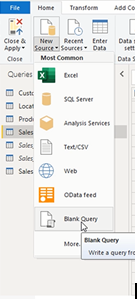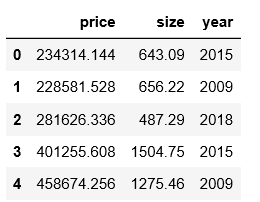Today we are gonna talk about the most important aspects - Time Intelligence. In Fact you will most probably use this script in most of the scenarios or analysis you do. The script we are gonna use today is the most common standard and one of the most handy scripts you should use while starting your analysis.
This script creates a date table in an instant according to the time difference of your choice and even lets you choose the FY beginnings. As in if your financial year starts from July or April you can simply let the script know and it will update the whole table accordingly.

let CreateDateTable =
(StartDate as date, EndDate as date, optional Culture as nullable text) as
table =>
let
DayCount =
Duration.Days(Duration.From(EndDate - StartDate)),
Source =
List.Dates(StartDate,DayCount,#duration(1,0,0,0)),
TableFromList
= Table.FromList(Source, Splitter.SplitByNothing()),
ChangedType
= Table.TransformColumnTypes(TableFromList,{{"Column1", type date}}),
RenamedColumns
= Table.RenameColumns(ChangedType,{{"Column1", "Date"}}),
InsertYear =
Table.AddColumn(RenamedColumns, "Year", each Date.Year([Date]), type
number),
InsertQuarter
= Table.AddColumn(InsertYear, "Quarter Num", each
Date.QuarterOfYear([Date]), type number),
InsertCalendarQtr
= Table.AddColumn(InsertQuarter, "Quarter Year", each "Q"
& Number.ToText([Quarter Num]) & " " &
Number.ToText([Year]),type text),
InsertCalendarQtrOrder
= Table.AddColumn(InsertCalendarQtr, "Quarter Year Order", each
[Year] * 10 + [Quarter Num], type number),
InsertMonth
= Table.AddColumn(InsertCalendarQtrOrder, "Month Num", each
Date.Month([Date]), type number),
InsertMonthName
= Table.AddColumn(InsertMonth, "Month Name", each Date.ToText([Date],
"MMMM", Culture), type text),
InsertMonthNameShort
= Table.AddColumn(InsertMonthName, "Month Name Short", each
Date.ToText([Date], "MMM", Culture), type text),
InsertCalendarMonth
= Table.AddColumn(InsertMonthNameShort, "Month Year", each
(try(Text.Range([Month Name],0,3)) otherwise [Month Name]) & " "
& Number.ToText([Year]), type text),
InsertCalendarMonthOrder
= Table.AddColumn(InsertCalendarMonth, "Month Year Order", each
[Year] * 100 + [Month Num], type number),
InsertWeek =
Table.AddColumn(InsertCalendarMonthOrder, "Week Num", each
Date.WeekOfYear([Date]), type number),
InsertCalendarWk
= Table.AddColumn(InsertWeek, "Week Year", each "W" &
Number.ToText([Week Num]) & " " & Number.ToText([Year]), type
text),
InsertCalendarWkOrder
= Table.AddColumn(InsertCalendarWk, "Week Year Order", each [Year] *
100 + [Week Num], type number),
InsertWeekEnding
= Table.AddColumn(InsertCalendarWkOrder, "Week Ending", each
Date.EndOfWeek([Date]), type date),
InsertDay =
Table.AddColumn(InsertWeekEnding, "Month Day Num", each
Date.Day([Date]), type number),
InsertDayInt
= Table.AddColumn(InsertDay, "Date Int", each [Year] * 10000 + [Month
Num] * 100 + [Month Day Num], type number),
InsertDayWeek
= Table.AddColumn(InsertDayInt, "Day Num Week", each
Date.DayOfWeek([Date]) + 1, type number),
InsertDayName
= Table.AddColumn(InsertDayWeek, "Day Name", each Date.ToText([Date],
"dddd", Culture), type text),
InsertWeekend
= Table.AddColumn(InsertDayName, "Weekend", each if [Day Num Week] =
1 then "Y" else if [Day Num Week] = 7 then "Y" else
"N", type text),
InsertDayNameShort
= Table.AddColumn(InsertWeekend, "Day Name Short", each
Date.ToText([Date], "ddd", Culture), type text),
InsertIndex
= Table.AddIndexColumn(InsertDayNameShort, "Index", 1, 1),
InsertDayOfYear
= Table.AddColumn(InsertIndex, "Day of Year", each
Date.DayOfYear([Date]), type number),
InsertCurrentDay
= Table.AddColumn(InsertDayOfYear, "Current Day?", each
Date.IsInCurrentDay([Date]), type logical),
InsertCurrentWeek
= Table.AddColumn(InsertCurrentDay, "Current Week?", each
Date.IsInCurrentWeek([Date]), type logical),
InsertCurrentMonth
= Table.AddColumn(InsertCurrentWeek, "Current Month?", each
Date.IsInCurrentMonth([Date]), type logical),
InsertCurrentQuarter
= Table.AddColumn(InsertCurrentMonth, "Current Quarter?", each
Date.IsInCurrentQuarter([Date]), type logical),
InsertCurrentYear
= Table.AddColumn(InsertCurrentQuarter, "Current Year?", each
Date.IsInCurrentYear([Date]), type logical),
InsertCompletedDay
= Table.AddColumn(InsertCurrentYear, "Completed Days", each if
DateTime.Date(DateTime.LocalNow()) > [Date] then "Y" else
"N", type text),
InsertCompletedWeek
= Table.AddColumn(InsertCompletedDay, "Completed Weeks", each if
(Date.Year(DateTime.Date(DateTime.LocalNow())) > Date.Year([Date])) then
"Y" else if (Date.Year(DateTime.Date(DateTime.LocalNow())) <
Date.Year([Date])) then "N" else if
(Date.WeekOfYear(DateTime.Date(DateTime.LocalNow())) >
Date.WeekOfYear([Date])) then "Y" else "N", type text),
InsertCompletedMonth
= Table.AddColumn(InsertCompletedWeek, "Completed Months", each if
(Date.Year(DateTime.Date(DateTime.LocalNow())) > Date.Year([Date])) then
"Y" else if (Date.Year(DateTime.Date(DateTime.LocalNow())) <
Date.Year([Date])) then "N" else if
(Date.Month(DateTime.Date(DateTime.LocalNow())) > Date.Month([Date])) then
"Y" else "N", type text),
InsertCompletedQuarter
= Table.AddColumn(InsertCompletedMonth, "Completed Quarters", each if
(Date.Year(DateTime.Date(DateTime.LocalNow())) > Date.Year([Date])) then
"Y" else if (Date.Year(DateTime.Date(DateTime.LocalNow())) <
Date.Year([Date])) then "N" else if (Date.QuarterOfYear
(DateTime.Date(DateTime.LocalNow()))> Date.QuarterOfYear([Date]))
then "Y" else "N", type text),
InsertCompletedYear
= Table.AddColumn(InsertCompletedQuarter, "Completed Years", each if
(Date.Year(DateTime.Date(DateTime.LocalNow())) > Date.Year([Date])) then
"Y" else "N", type text)
in
InsertCompletedYear
in
CreateDateTable

Then you can easily see your whole table created and you can use.
Try it at your end post any queries you have!




